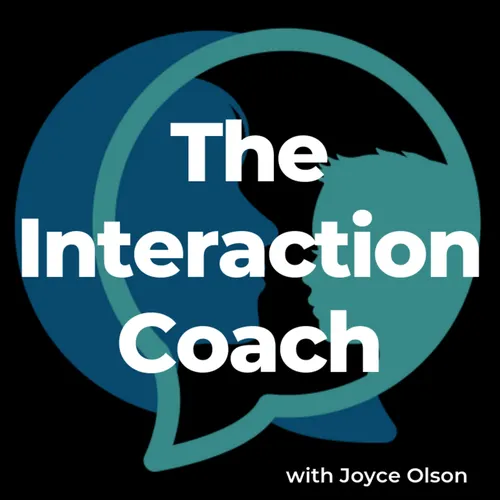
The Interaction Coach
You can help your child learn to talk with speech-language pathologist Joyce Olson of The Interaction Coach. Listen to daily tips that make every interaction a learning opportunity for speech and language development. Whether your child needs to start using words, make longer sentences, or improve social communication, this podcast is for you.
- Update frequency
- every day
- Average duration
- 6 minutes
- Episodes
- 234
- Years Active
- 2019 - 2020

2.074 LITERACY: Writing: Practice grasping and releasing
Send your questions and requests to me at [email protected]
Your child needs to develop fine motor skills in their fingers before they are ready to use writing or pointing.
At Level Two, your…

2.073 LITERACY: Reading: Add a book to bedtime routine
Sharing a book can be a calming activity before bed.
Today’s activity: Use a book with one or two sentences per page. Use a soothing voice to help with a calm transition to sleepy-time.
Send your que…

2.072 LITERACY: Reading: Independent exploration of books and environmental print
Environmental print includes pictures, symbols and words that are found in the world around us.
At Level Two, real objects are the best way for your child to learn about the world. However, calling a…

2.071 LITERACY: Reading: Explore a book together
Early literacy skills include book handling and recognizing pictures.
Your child will enjoy interacting with books with you. You can model how to pat the book page or point to a picture while you nam…

2.070 LANGUAGE: Use Speech: Use a familiar sound to initiate vocal play
You will notice your child has a favorite sound they use in babbling.
You can start to introduce the next step of imitation skills, but don’t expect your child to imitate consistently at this level.
…

2.069 LANGUAGE: Use Speech: Allow child to mouth a variety of objects
Mouthing helps your child learn about coordinating their mouth muscles and articulators (like their lips and tongue) that they need for making speech sounds.
Children naturally put everything into th…

2.068 LANGUAGE: Make Meaning: Exaggerate your intonation and expressions
You can help your child learn about the meaning expressed in your voice and facial expression by making them exaggerated. This calls attention to what you’re doing so it’s easier for your child to no…

2.067 LANGUAGE: Make Meaning: Imitate your child’s sounds
Your child will do lots of babbling at this level, experimenting with many different sounds. They learn to control their voice and mouth movements.
If your child does not babble much, have their hear…

2.066 LANGUAGE: Make Meaning: Respond to sounds when you are out of sight
When you appear as your child is making a sound, they learn that they can call for you. They will learn they can make you appear when they use their voice.
Today’s activity: When you hear your child …

2.065 LANGUAGE: Make Meaning: Respond to wiggles and sounds
We express meaning with words, but also with our intonation and body language. Your child is learning this from your examples at this level, while practicing the sounds they can make and the reasons …

2.064 LANGUAGE: Understand Words: Find partially covered object
Object permanence is the understanding that an object exists even when we can’t see it. Knowing this helps a child learn that a symbol (word) can represent an object that is not present.
At Level Two…

2.063 LANGUAGE: Understand Words: Recognize name
Using a word consistently in a situation helps a child attach meaning to that word. Your child’s name is one of the first words they learn to recognize.
Today’s activity: Use your child’s name to get…

2.062 LANGUAGE: Understand Words: Monitor child’s hearing
Your child must hear speech clearly so they can learn to make the sounds of speech clearly. Many children get fluid in their middle ears (otitis media) that can stay for weeks or months.
Today’s acti…

2.061 LANGUAGE: Understand Words: Localize sound
Language is the whole system we use for expressing our ideas, including sentences, words, grammar, sounds, intonation, etc. Speech (spoken words) is one modality we express language. Other modalities…

2.060 PLAY: Movement: Roll child side to side when “folded”
Your child rolls over by lifting their legs in the air and then moving them to the side so they roll onto their side.
After your child starts raising their legs on their own, you can help your child …

2.059 PLAY: Movement: Tickle chin with toes
Your child can learn the opposite of a sit-up exercise, raising their feet up to their chin.
Movement skills are important for exploring to learn more about things around them. If you notice a delay …

2.058 PLAY: Movement: Watch toy on belly
Movement is important so your child can explore their surroundings and learn more about their world—so they have more to talk about!
At Level Two, you child spends a lot of time exercising their musc…

2.057 PLAY: Object Use: Stimulate curiosity and exploration
Use child-safe toys that entice your child to try to reach them. When items are just out of reach, your child gets good exercise.
Encouraging your child to explore independently builds their initiati…

2.056 PLAY: Object Use: Play with a ball
You’ll see your child’s skills at picking up and holding things as you play back and forth with a ball. At first they will pick it up and wave it. By the end of this level they will be swatting the b…

2.055 PLAY: Object Use: Offer a second item
When your child wants to accept a new toy from you, they’ll drop an object that’s already in their hand.
The activity for today is an example of how you can start a habit at an early level that will …